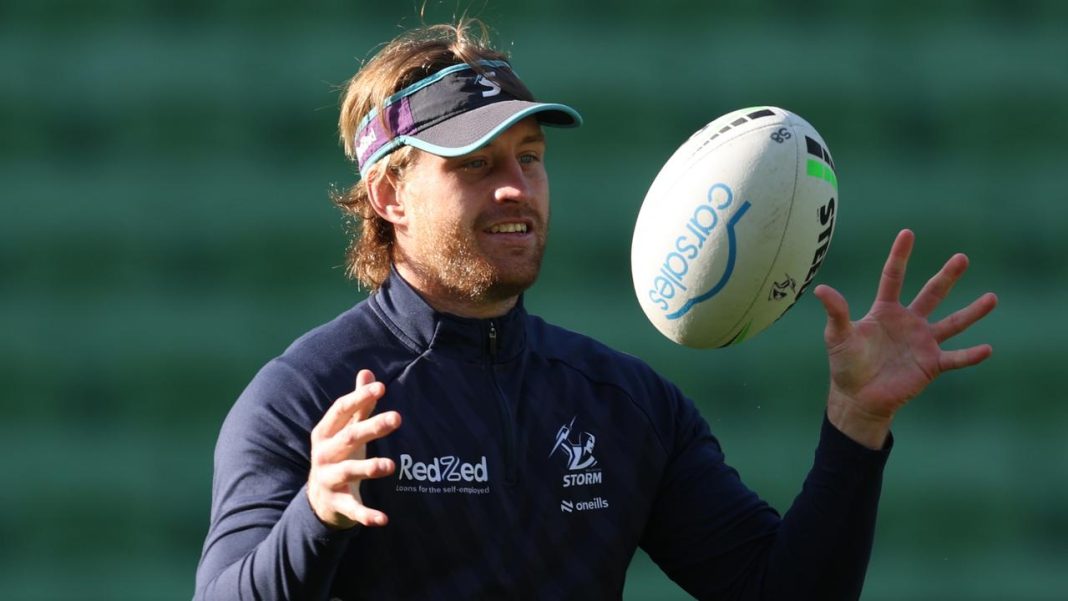Cameron Munster’s career as a five-eighth is fast becoming iconic — yet when it began he was crippled by anxiety that he was incapable of playing the position, Matty Johns has revealed.
Melbourne champion Billy Slater suffered a season-ending shoulder injury in Round 1 of the 2016 season, opening a path for Munster to return to the No.1 jersey after playing 19 games in 2015.
Fast forward to the 2017 season, with Slater returning, Craig Bellamy had to find a new position for the rising star.
FOX LEAGUE, available on Kayo Sports, is the only place to watch every game of every round in the 2025 NRL Telstra Premiership, LIVE with no ad-breaks during play. New to Kayo? Get your first month for just $1. Limited-time offer >
WHAT’S GAMBLING REALLY COSTING YOU? Set a deposit limit. For Free and confidential support call 1800 858 858 or visit gamblinghelponline.org.au.
Munster slotted into the five-eighth role, but according to Johns, he was convinced he didn’t have the ability to wear the No.6.
“I remember doing some stuff with Munster and he was having “enormous anxiety” about playing No.6. He didn’t believe he could do it,” Johns said on the Matty and Cronk podcast.
“The reason he didn’t believe he could do it, he thought he had to do the things that you (Cronk) did.
“Had to organise and ball play. Then he came to the conclusion, ‘I just have to play how I do, play unorthodox’.”
The rest, as they say, is history.
Sharks in danger as Bears chase Brailey | 02:23
Johns now regards Munster as one of the top Origin players of all time, as well as widely being regarding as one of rugby league’s best ever five-eighths.
He has also won two premierships and a staggering five Origin series.
Johns believed Munster was a rare case study in rugby league of players that have succeeded in making a full time positional switch from the outside backs to the halves.
For the league legend, Dolphins gun Jake Averillo is the perfect example of how a short-term switch can unlock the best of a player’s abilities.
The former Bulldogs star scored a double, but could easily have scored a handful more according to Johns.
However, a long-term move can make a player begin to doubt why they found success in their new position in the first place, with Averillo previously being unable to lock down a halves position during his time at Canterbury.
“I like it, (when) it’s for a short stint and you take an outside back and you put them in at No.6, a bit like I have a theory when wingers go to fullback,” Johns said.
“If they play two to three games they generally excel, when Averillo went to No.6 I thought this would suit him.
‘One finals win’: O’Brien Knights debate | 03:31
MORE NRL NEWS
MCKINNON: Next move Knights must nail, why O’Brien should walk before pushed
POWER RANKINGS: Big Bulldogs doubts as Broncos time run to perfection
NRLW TALKING PTS: Scary reality of Roosters’ big win, only team who can beat them
“Katoa can run the (game) and he can just do what he does, run the ball and he scored two tries. Very similar to Fletcher Sharpe.
“What happens is, suddenly they think they have to start playing like halves.”
Cooper Cronk echoed Johns’ opinion, saying: “It’s so true. Good athletic ball runners who play in the outside backs, when they move into a halves position.
“All of a sudden they become a ballplayer and a distributor. It’s a short term philosophy, because they just start thinking they need to be something they are not.
“The one thing Kristian Woolf can do for Averillo, is yes he’s wearing No.6 but I think he’s got to have a fullback mentality.
“The way Isaiya Katoa runs that ship, he has two fullbacks… that’s the way to keep him moving. He should always be second receiver out the back.”
That same game plan was implemented by the Storm when Munster transitioned to five-eighth, with Cronk being the primary playmaker, leaving Slater and Munster to deliver at second and third receiver.




